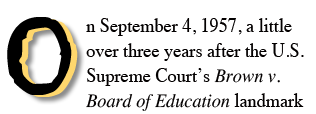 |
|

       |
|||
|
The ground troops selected to face the predictable onslaught were nine, carefully chosen students from Horace Mann and Dunbar, two all-black schools. The plan for that first day of school had been for all nine of the students to arrive in a group. However, one of the students, Elizabeth Eckford, found herself all alone, totally engulfed and surrounded by a swirling mob of angry and defiant white students and parents, with reporters and photographers thrown into the mix to record the historic event. Arkansas Democrat staff photographer Will Counts was to capture one of the more dramatic shots from that historic morning; it featured Elizabeth clutching her notebook, head held high, stoically walking amidst the threatening throng. The photo also spotlighted a contrasting figure to the brave and solitary black girl—Hazel Bryan, a white student the same age as Elizabeth. Following a few paces behind, Hazel’s face was contorted into a frightening mask of hate and unbridled rage. The iconic photograph of the two of them—surrounded by a mad circus of angry onlookers—was to become a lightning rod and rallying force for the fledgling civil rights movement. David Margolick’s literary documentary, Elizabeth and Hazel brings the photograph out into the bright light of the 21st century and peels it layer by layer with thoughtful detail to expose the blood, soul, life and breath of each of the women behind the image. Because, as Margolick illustrates in the book, the photograph was not to be the real story of Elizabeth and Hazel, but rather the capturing of the starting point of a life-long emotional, if not turbulent, relationship between these two Southern women from two totally different worlds of Arkansas. Several years after the picture was snapped, Hazel begins a journey of atonement, and the path leads straight back to Elizabeth and that fateful September morning. Elizabeth and Hazel chronicles the up-and-down story of the two women as they deal with the aftermath of the event, both separately and together. Margolick does a brilliant job of telling the story. He underscores the fact that change, even necessary change, is often painful and messy; and when you stick your finger in the face of the status quo, it’s more than likely to be bitten off. That being said, Margolick skillfully avoids delivering the message with a preachy or condescending tone; he simply lays the facts out in an accessible manner that makes for a great read. The book is insightful with regard to the early days of the civil rights movement, but without being judgmental. That’s not to say he lets the offenders off the hook; he just treats them fairly and lets their actions speak for themselves. The only disappointment is not the book, but rather the message itself, albeit an honest one. It comes down to more than scraping and collecting the essence off a 50-year-old photograph; Elizabeth and Hazel actual serves more as a microcosm of the racial divide that we still face as a region—and as a nation. Forgiveness needs to be a value as importantly embraced as tolerance and compassion. Until we, as a people, get to that point, pictures like the one from that September morning will continue to be snapped, and only the mobs and faces and victims and oppressors will continue to change. —David Ray Skinner |
|||
